Analyzing Customer Behavior: Digital Marketing & Data Analytics
VerifiedAdded on 2023/06/03
|8
|2205
|379
Report
AI Summary
This report explores the digital marketing landscape and its influence on consumer buying behavior, highlighting the shift from traditional methods to digital strategies. It contrasts traditional and digital marketing approaches, emphasizing the omnichannel customer journey and the significance of customer touchpoints. The report also examines how data analytics enables marketers to map the customer journey, enhance company performance, and improve customer experience. It further discusses the benefits of digital marketing for industries, including real-time results, brand development, and higher exposure. The role of data and analytics in understanding customer insights and targeting potential customers is also discussed, concluding that digital marketing offers a more effective and customer-centric approach compared to traditional marketing.
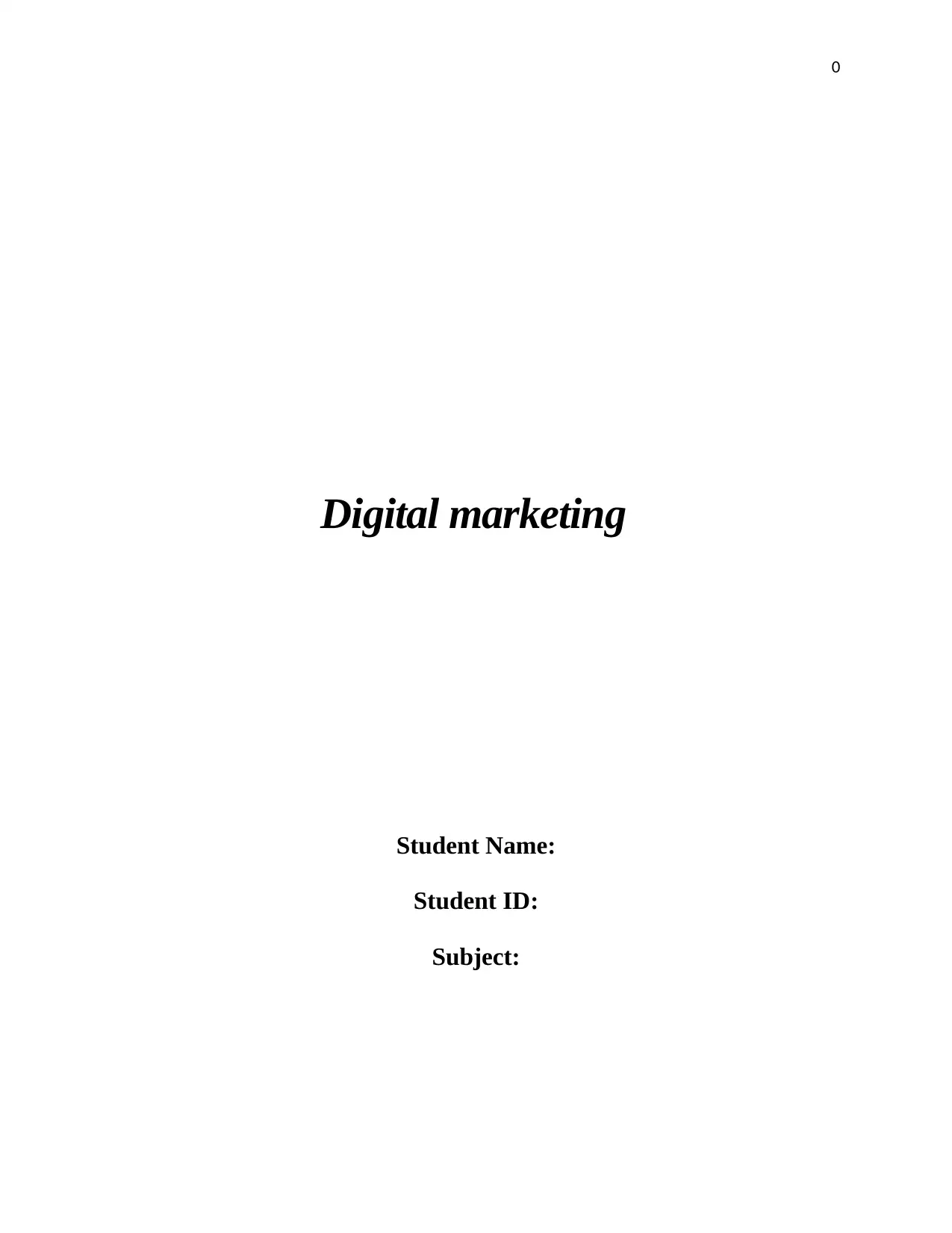
0
Digital marketing
Student Name:
Student ID:
Subject:
Digital marketing
Student Name:
Student ID:
Subject:
Paraphrase This Document
Need a fresh take? Get an instant paraphrase of this document with our AI Paraphraser
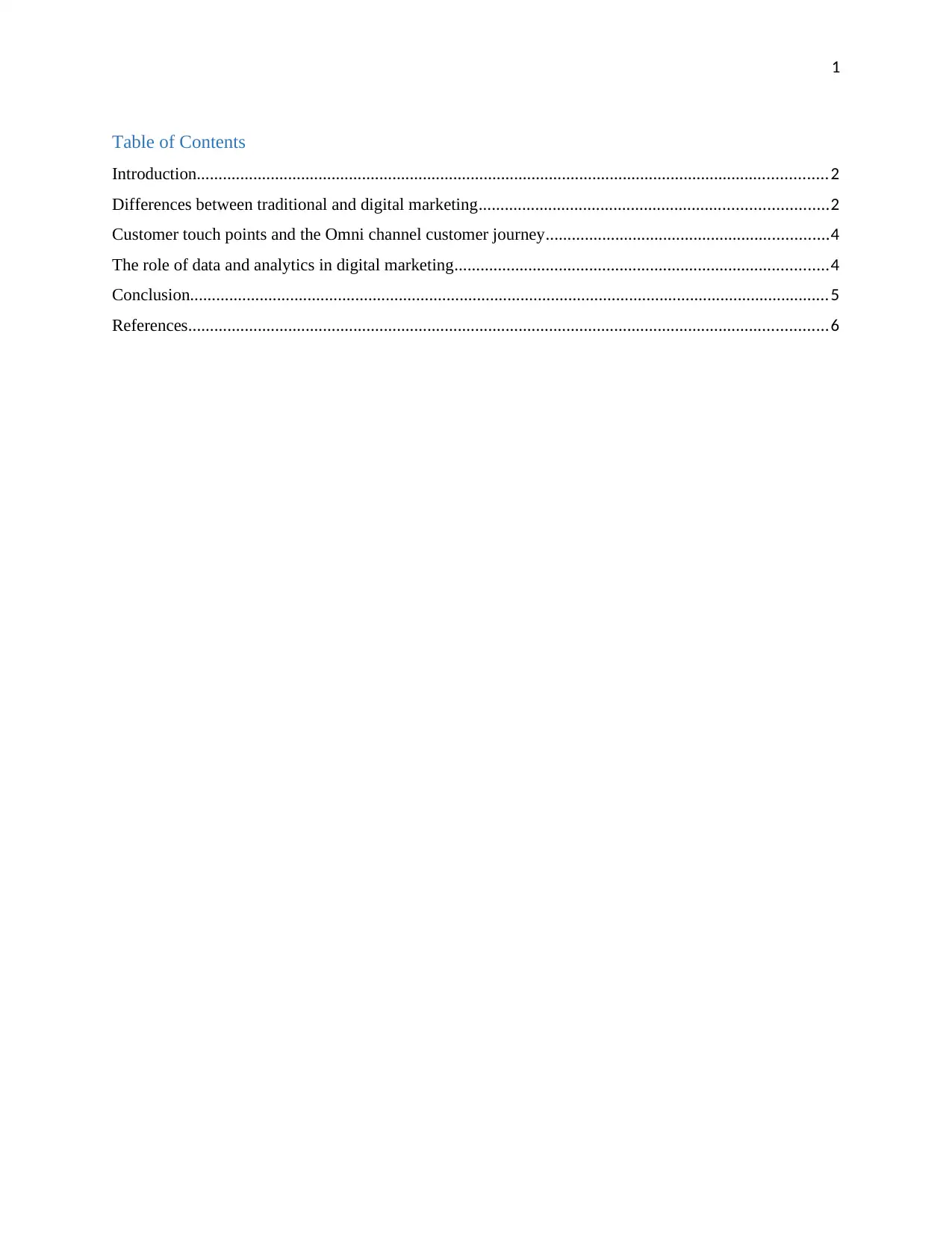
1
Table of Contents
Introduction.................................................................................................................................................2
Differences between traditional and digital marketing................................................................................2
Customer touch points and the Omni channel customer journey.................................................................4
The role of data and analytics in digital marketing......................................................................................4
Conclusion...................................................................................................................................................5
References...................................................................................................................................................6
Table of Contents
Introduction.................................................................................................................................................2
Differences between traditional and digital marketing................................................................................2
Customer touch points and the Omni channel customer journey.................................................................4
The role of data and analytics in digital marketing......................................................................................4
Conclusion...................................................................................................................................................5
References...................................................................................................................................................6
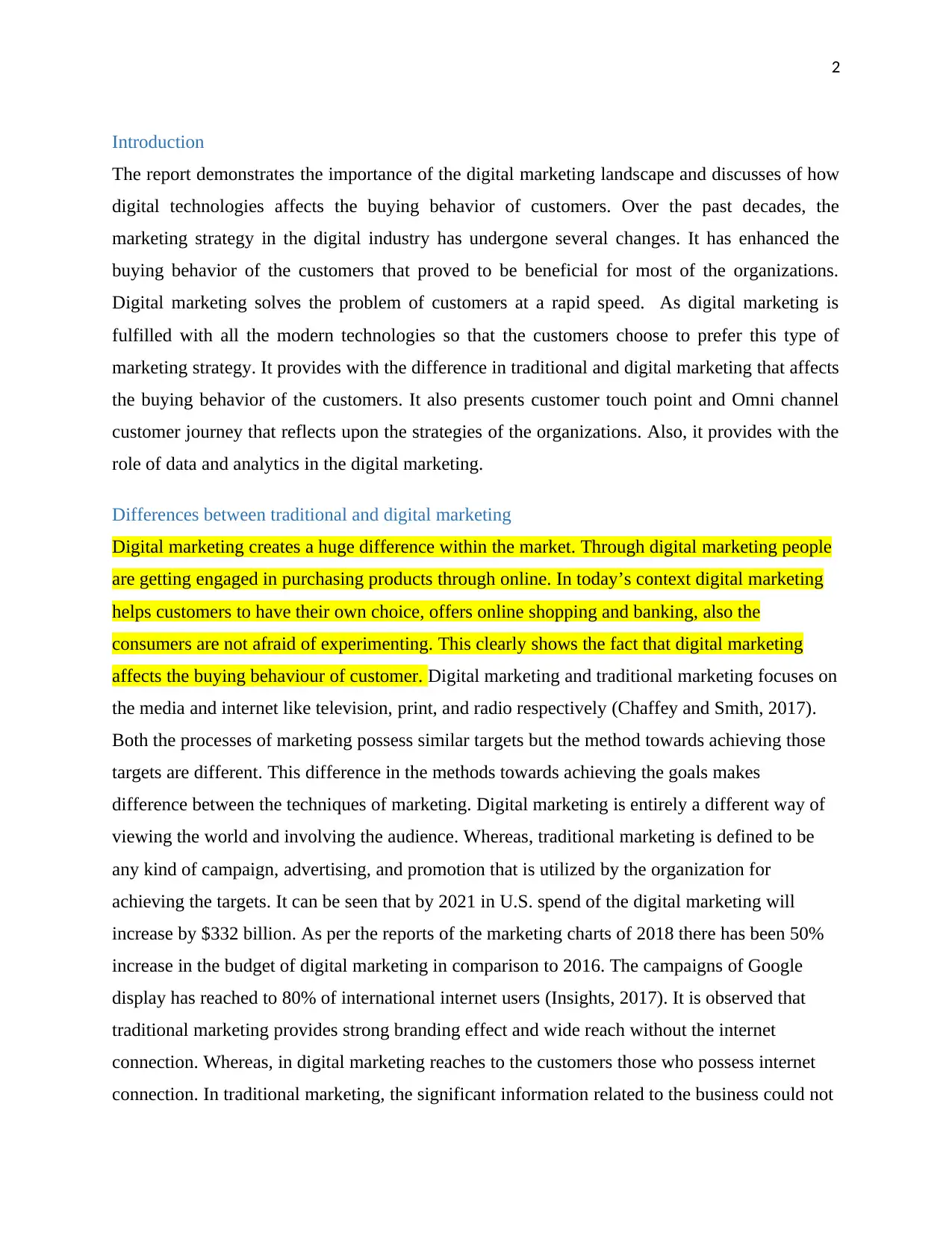
2
Introduction
The report demonstrates the importance of the digital marketing landscape and discusses of how
digital technologies affects the buying behavior of customers. Over the past decades, the
marketing strategy in the digital industry has undergone several changes. It has enhanced the
buying behavior of the customers that proved to be beneficial for most of the organizations.
Digital marketing solves the problem of customers at a rapid speed. As digital marketing is
fulfilled with all the modern technologies so that the customers choose to prefer this type of
marketing strategy. It provides with the difference in traditional and digital marketing that affects
the buying behavior of the customers. It also presents customer touch point and Omni channel
customer journey that reflects upon the strategies of the organizations. Also, it provides with the
role of data and analytics in the digital marketing.
Differences between traditional and digital marketing
Digital marketing creates a huge difference within the market. Through digital marketing people
are getting engaged in purchasing products through online. In today’s context digital marketing
helps customers to have their own choice, offers online shopping and banking, also the
consumers are not afraid of experimenting. This clearly shows the fact that digital marketing
affects the buying behaviour of customer. Digital marketing and traditional marketing focuses on
the media and internet like television, print, and radio respectively (Chaffey and Smith, 2017).
Both the processes of marketing possess similar targets but the method towards achieving those
targets are different. This difference in the methods towards achieving the goals makes
difference between the techniques of marketing. Digital marketing is entirely a different way of
viewing the world and involving the audience. Whereas, traditional marketing is defined to be
any kind of campaign, advertising, and promotion that is utilized by the organization for
achieving the targets. It can be seen that by 2021 in U.S. spend of the digital marketing will
increase by $332 billion. As per the reports of the marketing charts of 2018 there has been 50%
increase in the budget of digital marketing in comparison to 2016. The campaigns of Google
display has reached to 80% of international internet users (Insights, 2017). It is observed that
traditional marketing provides strong branding effect and wide reach without the internet
connection. Whereas, in digital marketing reaches to the customers those who possess internet
connection. In traditional marketing, the significant information related to the business could not
Introduction
The report demonstrates the importance of the digital marketing landscape and discusses of how
digital technologies affects the buying behavior of customers. Over the past decades, the
marketing strategy in the digital industry has undergone several changes. It has enhanced the
buying behavior of the customers that proved to be beneficial for most of the organizations.
Digital marketing solves the problem of customers at a rapid speed. As digital marketing is
fulfilled with all the modern technologies so that the customers choose to prefer this type of
marketing strategy. It provides with the difference in traditional and digital marketing that affects
the buying behavior of the customers. It also presents customer touch point and Omni channel
customer journey that reflects upon the strategies of the organizations. Also, it provides with the
role of data and analytics in the digital marketing.
Differences between traditional and digital marketing
Digital marketing creates a huge difference within the market. Through digital marketing people
are getting engaged in purchasing products through online. In today’s context digital marketing
helps customers to have their own choice, offers online shopping and banking, also the
consumers are not afraid of experimenting. This clearly shows the fact that digital marketing
affects the buying behaviour of customer. Digital marketing and traditional marketing focuses on
the media and internet like television, print, and radio respectively (Chaffey and Smith, 2017).
Both the processes of marketing possess similar targets but the method towards achieving those
targets are different. This difference in the methods towards achieving the goals makes
difference between the techniques of marketing. Digital marketing is entirely a different way of
viewing the world and involving the audience. Whereas, traditional marketing is defined to be
any kind of campaign, advertising, and promotion that is utilized by the organization for
achieving the targets. It can be seen that by 2021 in U.S. spend of the digital marketing will
increase by $332 billion. As per the reports of the marketing charts of 2018 there has been 50%
increase in the budget of digital marketing in comparison to 2016. The campaigns of Google
display has reached to 80% of international internet users (Insights, 2017). It is observed that
traditional marketing provides strong branding effect and wide reach without the internet
connection. Whereas, in digital marketing reaches to the customers those who possess internet
connection. In traditional marketing, the significant information related to the business could not
⊘ This is a preview!⊘
Do you want full access?
Subscribe today to unlock all pages.

Trusted by 1+ million students worldwide
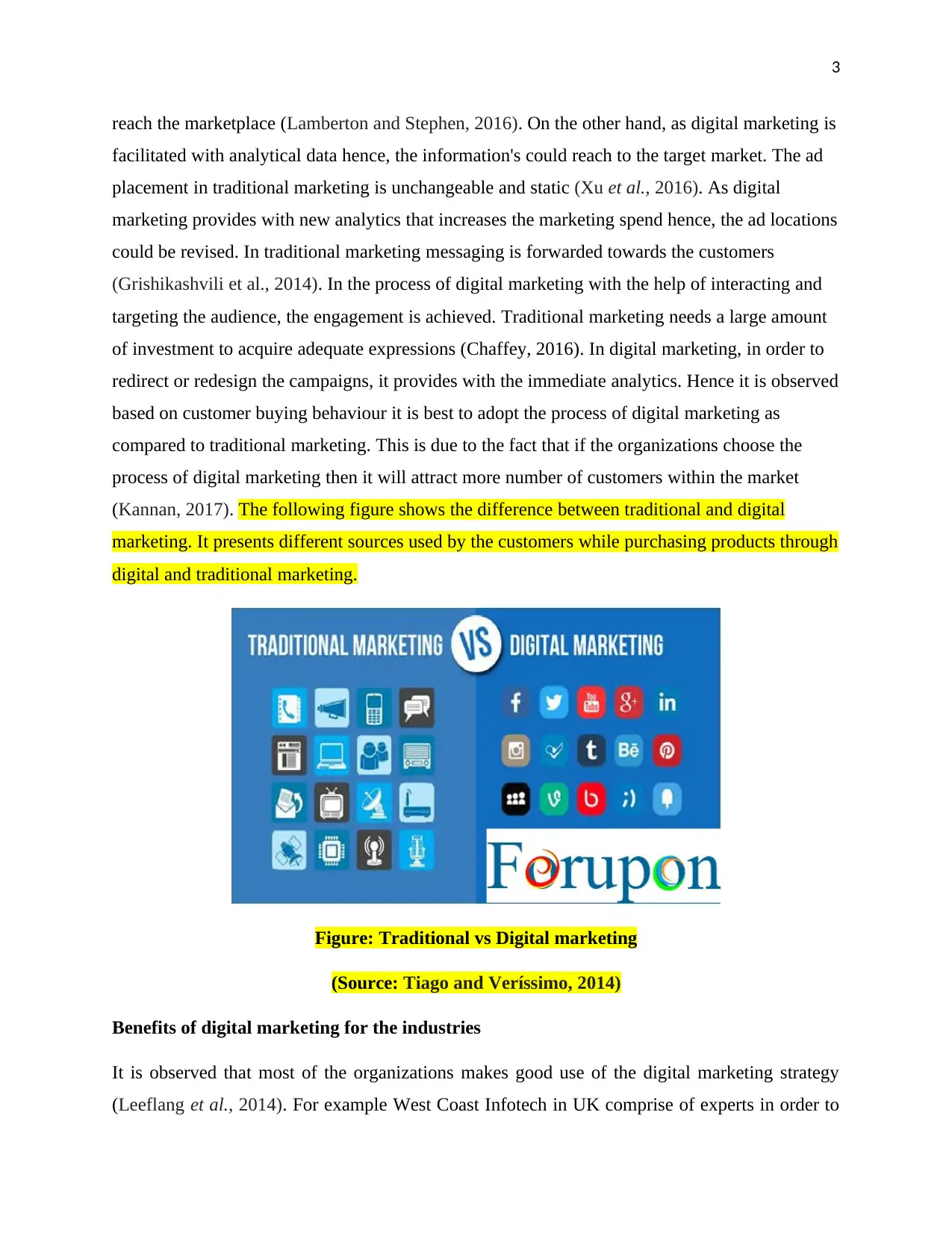
3
reach the marketplace (Lamberton and Stephen, 2016). On the other hand, as digital marketing is
facilitated with analytical data hence, the information's could reach to the target market. The ad
placement in traditional marketing is unchangeable and static (Xu et al., 2016). As digital
marketing provides with new analytics that increases the marketing spend hence, the ad locations
could be revised. In traditional marketing messaging is forwarded towards the customers
(Grishikashvili et al., 2014). In the process of digital marketing with the help of interacting and
targeting the audience, the engagement is achieved. Traditional marketing needs a large amount
of investment to acquire adequate expressions (Chaffey, 2016). In digital marketing, in order to
redirect or redesign the campaigns, it provides with the immediate analytics. Hence it is observed
based on customer buying behaviour it is best to adopt the process of digital marketing as
compared to traditional marketing. This is due to the fact that if the organizations choose the
process of digital marketing then it will attract more number of customers within the market
(Kannan, 2017). The following figure shows the difference between traditional and digital
marketing. It presents different sources used by the customers while purchasing products through
digital and traditional marketing.
Figure: Traditional vs Digital marketing
(Source: Tiago and Veríssimo, 2014)
Benefits of digital marketing for the industries
It is observed that most of the organizations makes good use of the digital marketing strategy
(Leeflang et al., 2014). For example West Coast Infotech in UK comprise of experts in order to
reach the marketplace (Lamberton and Stephen, 2016). On the other hand, as digital marketing is
facilitated with analytical data hence, the information's could reach to the target market. The ad
placement in traditional marketing is unchangeable and static (Xu et al., 2016). As digital
marketing provides with new analytics that increases the marketing spend hence, the ad locations
could be revised. In traditional marketing messaging is forwarded towards the customers
(Grishikashvili et al., 2014). In the process of digital marketing with the help of interacting and
targeting the audience, the engagement is achieved. Traditional marketing needs a large amount
of investment to acquire adequate expressions (Chaffey, 2016). In digital marketing, in order to
redirect or redesign the campaigns, it provides with the immediate analytics. Hence it is observed
based on customer buying behaviour it is best to adopt the process of digital marketing as
compared to traditional marketing. This is due to the fact that if the organizations choose the
process of digital marketing then it will attract more number of customers within the market
(Kannan, 2017). The following figure shows the difference between traditional and digital
marketing. It presents different sources used by the customers while purchasing products through
digital and traditional marketing.
Figure: Traditional vs Digital marketing
(Source: Tiago and Veríssimo, 2014)
Benefits of digital marketing for the industries
It is observed that most of the organizations makes good use of the digital marketing strategy
(Leeflang et al., 2014). For example West Coast Infotech in UK comprise of experts in order to
Paraphrase This Document
Need a fresh take? Get an instant paraphrase of this document with our AI Paraphraser
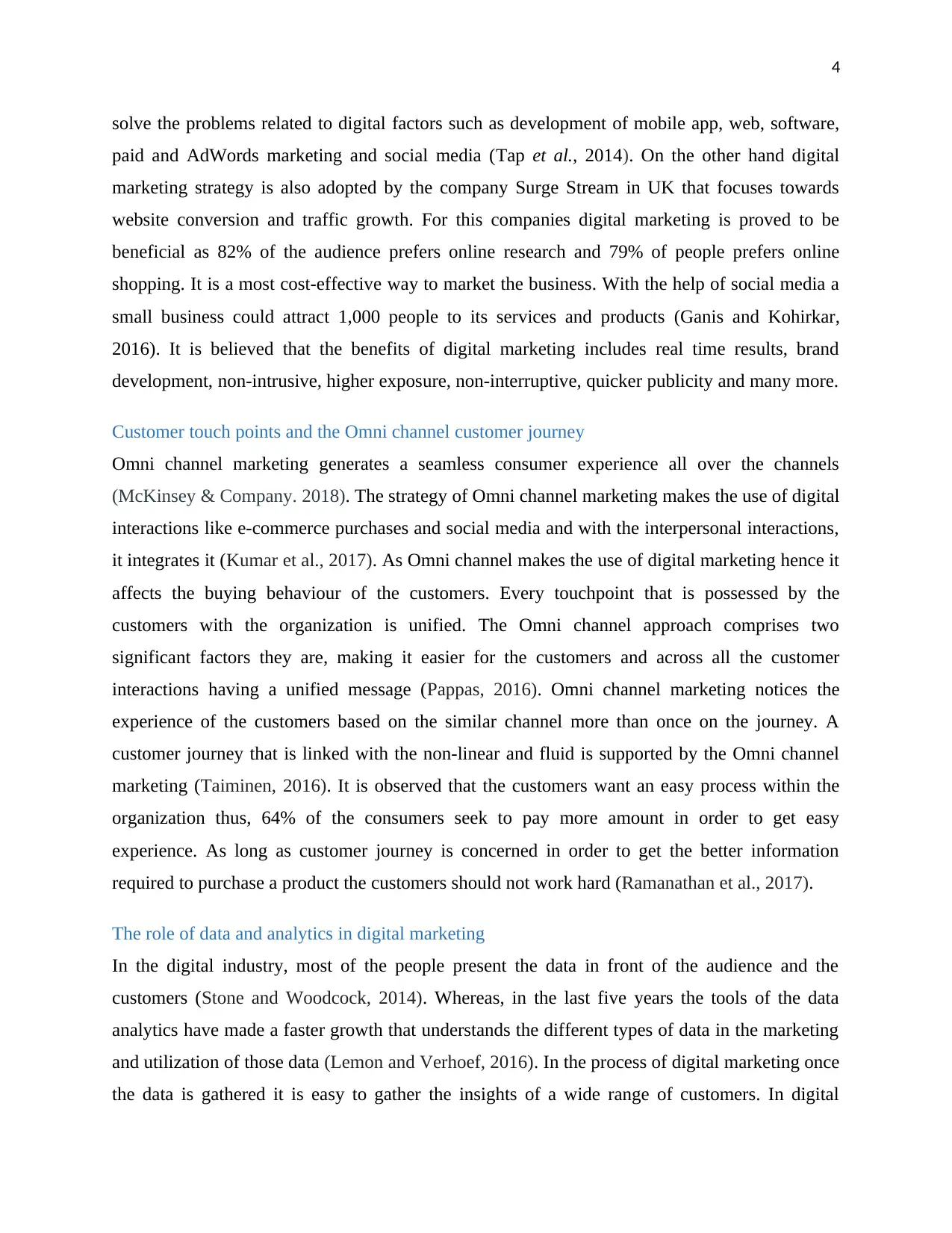
4
solve the problems related to digital factors such as development of mobile app, web, software,
paid and AdWords marketing and social media (Tap et al., 2014). On the other hand digital
marketing strategy is also adopted by the company Surge Stream in UK that focuses towards
website conversion and traffic growth. For this companies digital marketing is proved to be
beneficial as 82% of the audience prefers online research and 79% of people prefers online
shopping. It is a most cost-effective way to market the business. With the help of social media a
small business could attract 1,000 people to its services and products (Ganis and Kohirkar,
2016). It is believed that the benefits of digital marketing includes real time results, brand
development, non-intrusive, higher exposure, non-interruptive, quicker publicity and many more.
Customer touch points and the Omni channel customer journey
Omni channel marketing generates a seamless consumer experience all over the channels
(McKinsey & Company. 2018). The strategy of Omni channel marketing makes the use of digital
interactions like e-commerce purchases and social media and with the interpersonal interactions,
it integrates it (Kumar et al., 2017). As Omni channel makes the use of digital marketing hence it
affects the buying behaviour of the customers. Every touchpoint that is possessed by the
customers with the organization is unified. The Omni channel approach comprises two
significant factors they are, making it easier for the customers and across all the customer
interactions having a unified message (Pappas, 2016). Omni channel marketing notices the
experience of the customers based on the similar channel more than once on the journey. A
customer journey that is linked with the non-linear and fluid is supported by the Omni channel
marketing (Taiminen, 2016). It is observed that the customers want an easy process within the
organization thus, 64% of the consumers seek to pay more amount in order to get easy
experience. As long as customer journey is concerned in order to get the better information
required to purchase a product the customers should not work hard (Ramanathan et al., 2017).
The role of data and analytics in digital marketing
In the digital industry, most of the people present the data in front of the audience and the
customers (Stone and Woodcock, 2014). Whereas, in the last five years the tools of the data
analytics have made a faster growth that understands the different types of data in the marketing
and utilization of those data (Lemon and Verhoef, 2016). In the process of digital marketing once
the data is gathered it is easy to gather the insights of a wide range of customers. In digital
solve the problems related to digital factors such as development of mobile app, web, software,
paid and AdWords marketing and social media (Tap et al., 2014). On the other hand digital
marketing strategy is also adopted by the company Surge Stream in UK that focuses towards
website conversion and traffic growth. For this companies digital marketing is proved to be
beneficial as 82% of the audience prefers online research and 79% of people prefers online
shopping. It is a most cost-effective way to market the business. With the help of social media a
small business could attract 1,000 people to its services and products (Ganis and Kohirkar,
2016). It is believed that the benefits of digital marketing includes real time results, brand
development, non-intrusive, higher exposure, non-interruptive, quicker publicity and many more.
Customer touch points and the Omni channel customer journey
Omni channel marketing generates a seamless consumer experience all over the channels
(McKinsey & Company. 2018). The strategy of Omni channel marketing makes the use of digital
interactions like e-commerce purchases and social media and with the interpersonal interactions,
it integrates it (Kumar et al., 2017). As Omni channel makes the use of digital marketing hence it
affects the buying behaviour of the customers. Every touchpoint that is possessed by the
customers with the organization is unified. The Omni channel approach comprises two
significant factors they are, making it easier for the customers and across all the customer
interactions having a unified message (Pappas, 2016). Omni channel marketing notices the
experience of the customers based on the similar channel more than once on the journey. A
customer journey that is linked with the non-linear and fluid is supported by the Omni channel
marketing (Taiminen, 2016). It is observed that the customers want an easy process within the
organization thus, 64% of the consumers seek to pay more amount in order to get easy
experience. As long as customer journey is concerned in order to get the better information
required to purchase a product the customers should not work hard (Ramanathan et al., 2017).
The role of data and analytics in digital marketing
In the digital industry, most of the people present the data in front of the audience and the
customers (Stone and Woodcock, 2014). Whereas, in the last five years the tools of the data
analytics have made a faster growth that understands the different types of data in the marketing
and utilization of those data (Lemon and Verhoef, 2016). In the process of digital marketing once
the data is gathered it is easy to gather the insights of a wide range of customers. In digital
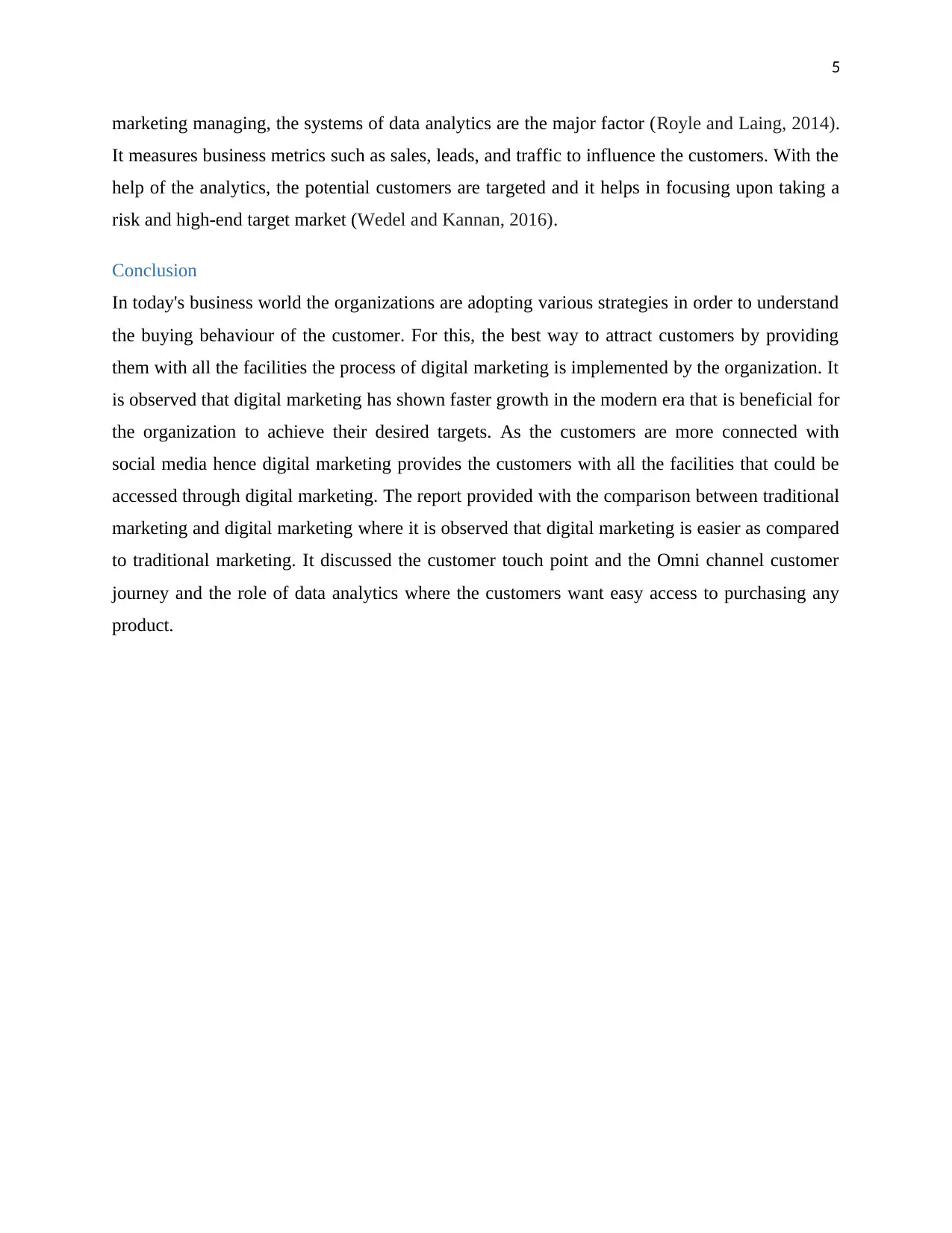
5
marketing managing, the systems of data analytics are the major factor (Royle and Laing, 2014).
It measures business metrics such as sales, leads, and traffic to influence the customers. With the
help of the analytics, the potential customers are targeted and it helps in focusing upon taking a
risk and high-end target market (Wedel and Kannan, 2016).
Conclusion
In today's business world the organizations are adopting various strategies in order to understand
the buying behaviour of the customer. For this, the best way to attract customers by providing
them with all the facilities the process of digital marketing is implemented by the organization. It
is observed that digital marketing has shown faster growth in the modern era that is beneficial for
the organization to achieve their desired targets. As the customers are more connected with
social media hence digital marketing provides the customers with all the facilities that could be
accessed through digital marketing. The report provided with the comparison between traditional
marketing and digital marketing where it is observed that digital marketing is easier as compared
to traditional marketing. It discussed the customer touch point and the Omni channel customer
journey and the role of data analytics where the customers want easy access to purchasing any
product.
marketing managing, the systems of data analytics are the major factor (Royle and Laing, 2014).
It measures business metrics such as sales, leads, and traffic to influence the customers. With the
help of the analytics, the potential customers are targeted and it helps in focusing upon taking a
risk and high-end target market (Wedel and Kannan, 2016).
Conclusion
In today's business world the organizations are adopting various strategies in order to understand
the buying behaviour of the customer. For this, the best way to attract customers by providing
them with all the facilities the process of digital marketing is implemented by the organization. It
is observed that digital marketing has shown faster growth in the modern era that is beneficial for
the organization to achieve their desired targets. As the customers are more connected with
social media hence digital marketing provides the customers with all the facilities that could be
accessed through digital marketing. The report provided with the comparison between traditional
marketing and digital marketing where it is observed that digital marketing is easier as compared
to traditional marketing. It discussed the customer touch point and the Omni channel customer
journey and the role of data analytics where the customers want easy access to purchasing any
product.
⊘ This is a preview!⊘
Do you want full access?
Subscribe today to unlock all pages.

Trusted by 1+ million students worldwide
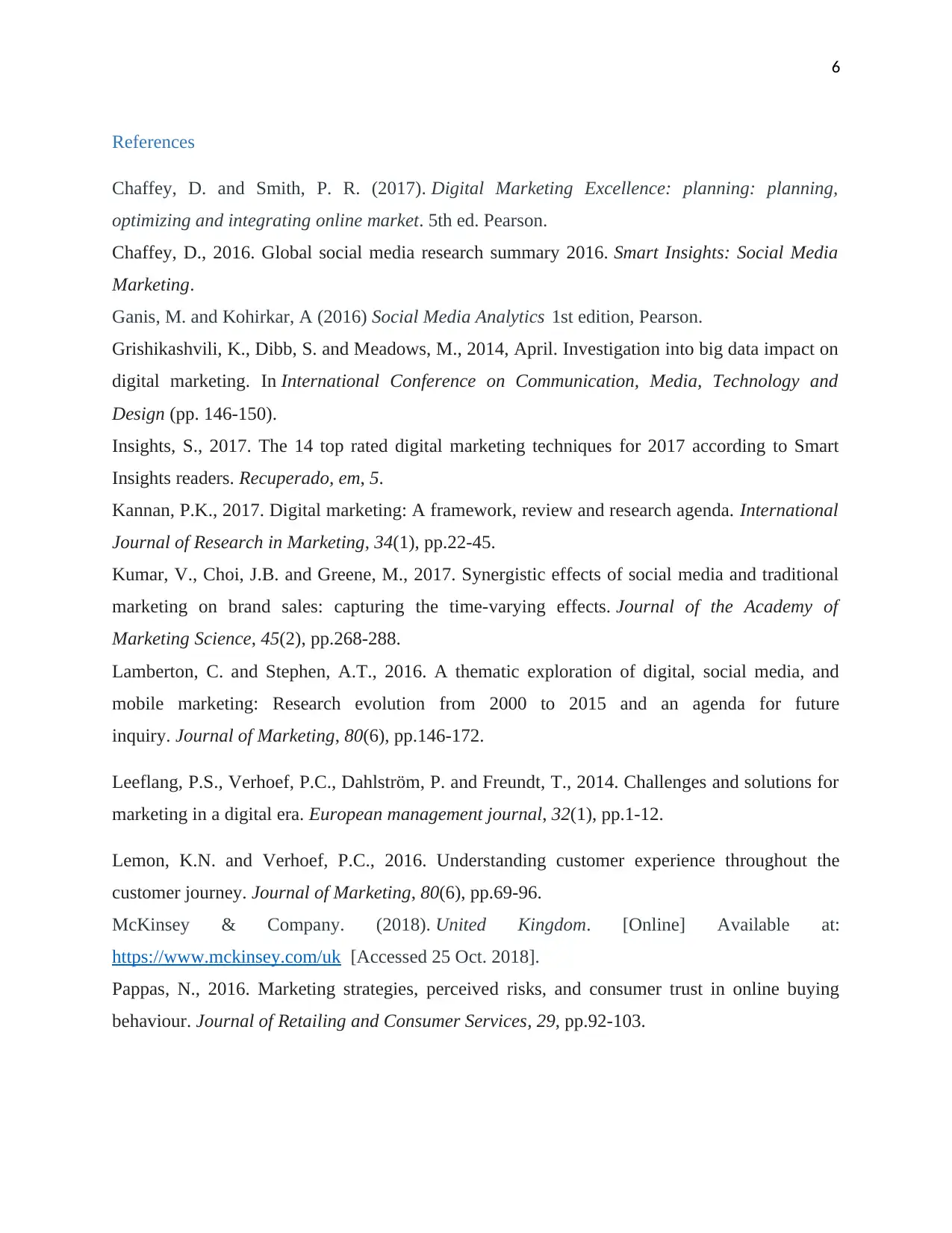
6
References
Chaffey, D. and Smith, P. R. (2017). Digital Marketing Excellence: planning: planning,
optimizing and integrating online market. 5th ed. Pearson.
Chaffey, D., 2016. Global social media research summary 2016. Smart Insights: Social Media
Marketing.
Ganis, M. and Kohirkar, A (2016) Social Media Analytics 1st edition, Pearson.
Grishikashvili, K., Dibb, S. and Meadows, M., 2014, April. Investigation into big data impact on
digital marketing. In International Conference on Communication, Media, Technology and
Design (pp. 146-150).
Insights, S., 2017. The 14 top rated digital marketing techniques for 2017 according to Smart
Insights readers. Recuperado, em, 5.
Kannan, P.K., 2017. Digital marketing: A framework, review and research agenda. International
Journal of Research in Marketing, 34(1), pp.22-45.
Kumar, V., Choi, J.B. and Greene, M., 2017. Synergistic effects of social media and traditional
marketing on brand sales: capturing the time-varying effects. Journal of the Academy of
Marketing Science, 45(2), pp.268-288.
Lamberton, C. and Stephen, A.T., 2016. A thematic exploration of digital, social media, and
mobile marketing: Research evolution from 2000 to 2015 and an agenda for future
inquiry. Journal of Marketing, 80(6), pp.146-172.
Leeflang, P.S., Verhoef, P.C., Dahlström, P. and Freundt, T., 2014. Challenges and solutions for
marketing in a digital era. European management journal, 32(1), pp.1-12.
Lemon, K.N. and Verhoef, P.C., 2016. Understanding customer experience throughout the
customer journey. Journal of Marketing, 80(6), pp.69-96.
McKinsey & Company. (2018). United Kingdom. [Online] Available at:
https://www.mckinsey.com/uk [Accessed 25 Oct. 2018].
Pappas, N., 2016. Marketing strategies, perceived risks, and consumer trust in online buying
behaviour. Journal of Retailing and Consumer Services, 29, pp.92-103.
References
Chaffey, D. and Smith, P. R. (2017). Digital Marketing Excellence: planning: planning,
optimizing and integrating online market. 5th ed. Pearson.
Chaffey, D., 2016. Global social media research summary 2016. Smart Insights: Social Media
Marketing.
Ganis, M. and Kohirkar, A (2016) Social Media Analytics 1st edition, Pearson.
Grishikashvili, K., Dibb, S. and Meadows, M., 2014, April. Investigation into big data impact on
digital marketing. In International Conference on Communication, Media, Technology and
Design (pp. 146-150).
Insights, S., 2017. The 14 top rated digital marketing techniques for 2017 according to Smart
Insights readers. Recuperado, em, 5.
Kannan, P.K., 2017. Digital marketing: A framework, review and research agenda. International
Journal of Research in Marketing, 34(1), pp.22-45.
Kumar, V., Choi, J.B. and Greene, M., 2017. Synergistic effects of social media and traditional
marketing on brand sales: capturing the time-varying effects. Journal of the Academy of
Marketing Science, 45(2), pp.268-288.
Lamberton, C. and Stephen, A.T., 2016. A thematic exploration of digital, social media, and
mobile marketing: Research evolution from 2000 to 2015 and an agenda for future
inquiry. Journal of Marketing, 80(6), pp.146-172.
Leeflang, P.S., Verhoef, P.C., Dahlström, P. and Freundt, T., 2014. Challenges and solutions for
marketing in a digital era. European management journal, 32(1), pp.1-12.
Lemon, K.N. and Verhoef, P.C., 2016. Understanding customer experience throughout the
customer journey. Journal of Marketing, 80(6), pp.69-96.
McKinsey & Company. (2018). United Kingdom. [Online] Available at:
https://www.mckinsey.com/uk [Accessed 25 Oct. 2018].
Pappas, N., 2016. Marketing strategies, perceived risks, and consumer trust in online buying
behaviour. Journal of Retailing and Consumer Services, 29, pp.92-103.
Paraphrase This Document
Need a fresh take? Get an instant paraphrase of this document with our AI Paraphraser
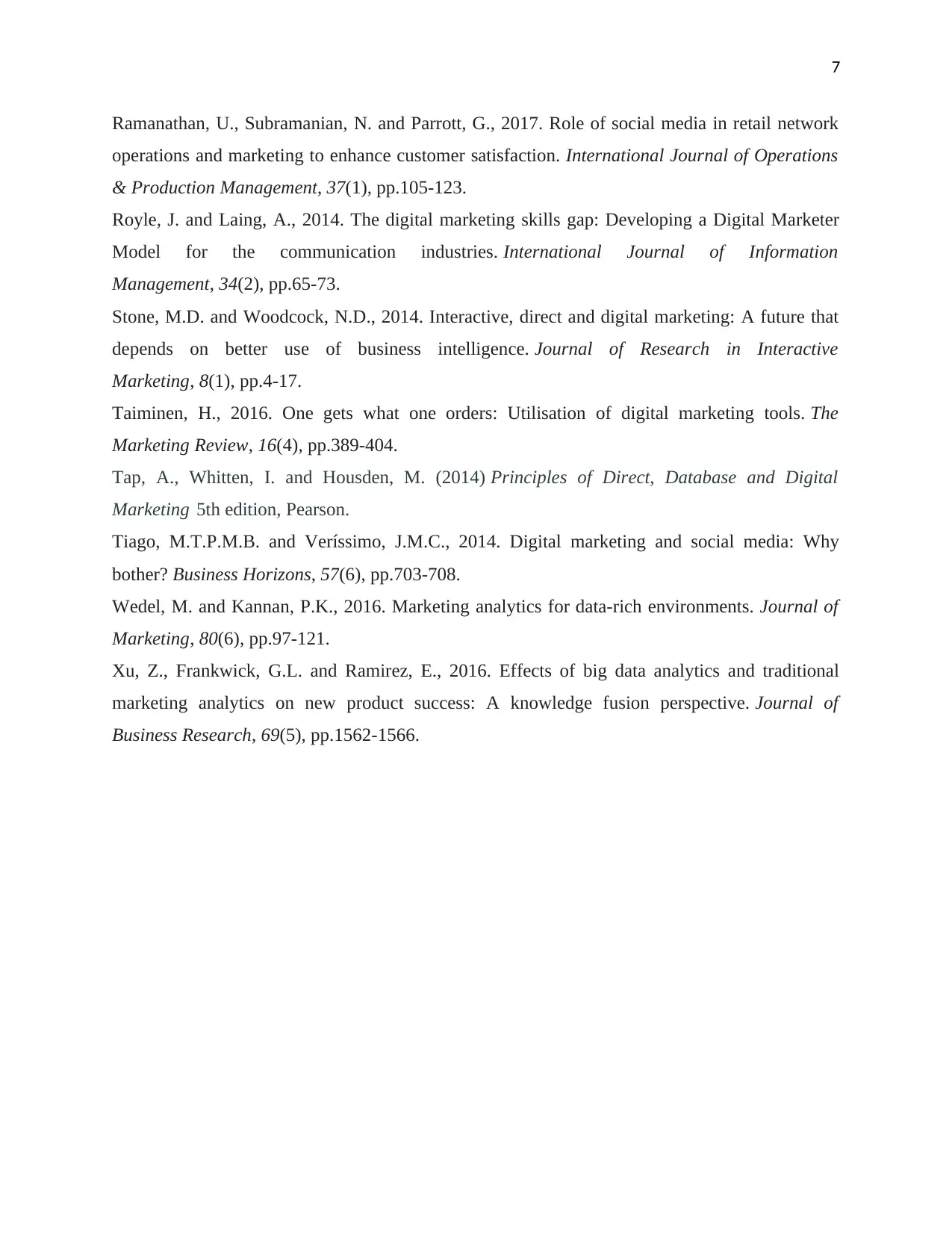
7
Ramanathan, U., Subramanian, N. and Parrott, G., 2017. Role of social media in retail network
operations and marketing to enhance customer satisfaction. International Journal of Operations
& Production Management, 37(1), pp.105-123.
Royle, J. and Laing, A., 2014. The digital marketing skills gap: Developing a Digital Marketer
Model for the communication industries. International Journal of Information
Management, 34(2), pp.65-73.
Stone, M.D. and Woodcock, N.D., 2014. Interactive, direct and digital marketing: A future that
depends on better use of business intelligence. Journal of Research in Interactive
Marketing, 8(1), pp.4-17.
Taiminen, H., 2016. One gets what one orders: Utilisation of digital marketing tools. The
Marketing Review, 16(4), pp.389-404.
Tap, A., Whitten, I. and Housden, M. (2014) Principles of Direct, Database and Digital
Marketing 5th edition, Pearson.
Tiago, M.T.P.M.B. and Veríssimo, J.M.C., 2014. Digital marketing and social media: Why
bother? Business Horizons, 57(6), pp.703-708.
Wedel, M. and Kannan, P.K., 2016. Marketing analytics for data-rich environments. Journal of
Marketing, 80(6), pp.97-121.
Xu, Z., Frankwick, G.L. and Ramirez, E., 2016. Effects of big data analytics and traditional
marketing analytics on new product success: A knowledge fusion perspective. Journal of
Business Research, 69(5), pp.1562-1566.
Ramanathan, U., Subramanian, N. and Parrott, G., 2017. Role of social media in retail network
operations and marketing to enhance customer satisfaction. International Journal of Operations
& Production Management, 37(1), pp.105-123.
Royle, J. and Laing, A., 2014. The digital marketing skills gap: Developing a Digital Marketer
Model for the communication industries. International Journal of Information
Management, 34(2), pp.65-73.
Stone, M.D. and Woodcock, N.D., 2014. Interactive, direct and digital marketing: A future that
depends on better use of business intelligence. Journal of Research in Interactive
Marketing, 8(1), pp.4-17.
Taiminen, H., 2016. One gets what one orders: Utilisation of digital marketing tools. The
Marketing Review, 16(4), pp.389-404.
Tap, A., Whitten, I. and Housden, M. (2014) Principles of Direct, Database and Digital
Marketing 5th edition, Pearson.
Tiago, M.T.P.M.B. and Veríssimo, J.M.C., 2014. Digital marketing and social media: Why
bother? Business Horizons, 57(6), pp.703-708.
Wedel, M. and Kannan, P.K., 2016. Marketing analytics for data-rich environments. Journal of
Marketing, 80(6), pp.97-121.
Xu, Z., Frankwick, G.L. and Ramirez, E., 2016. Effects of big data analytics and traditional
marketing analytics on new product success: A knowledge fusion perspective. Journal of
Business Research, 69(5), pp.1562-1566.
1 out of 8
Related Documents
Your All-in-One AI-Powered Toolkit for Academic Success.
+13062052269
info@desklib.com
Available 24*7 on WhatsApp / Email
![[object Object]](/_next/static/media/star-bottom.7253800d.svg)
Unlock your academic potential
Copyright © 2020–2025 A2Z Services. All Rights Reserved. Developed and managed by ZUCOL.





